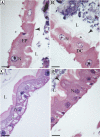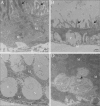Multiple Modes of Action of the Squamocin in the Midgut Cells of Aedes aegypti Larvae
- PMID: 27532504
- PMCID: PMC4988707
- DOI: 10.1371/journal.pone.0160928
Multiple Modes of Action of the Squamocin in the Midgut Cells of Aedes aegypti Larvae
Abstract
Annonaceous acetogenins are botanical compounds with good potential for use as insecticides. In the vector, Aedes aegypti (L.) (Diptera: Culicidae), squamocin (acetogenin) has been reported to be a larvicide and cytotoxic, but the modes of action of this molecule are still poorly understood. This study evaluated the changes in the cell morphology, and in the expression of genes, for autophagy (Atg1 and Atg8), for membrane ion transporter V-ATPase, and for water channel aquaporin-4 (Aqp4) in the midgut of A. aegypti larvae exposed to squamocin from Annona mucosa Jacq. (Annonaceae). Squamocin showed cytotoxic action with changes in the midgut epithelium and digestive cells of A. aegypti larvae, increase in the expression for autophagy gene Atg1 and Atg8, decrease in the expression of V-ATPase, decrease in the expression of Aqp4 gene in LC20 and inhibition of Apq4 genes in the midgut of this vector in LC50. These multiple modes of action for squamocin are described for the first time in insects, and they are important because different sites of action of squamocin from A. mucosa may reduce the possibility of resistance of A. aegypti to this molecule.
Conflict of interest statement
Figures







Similar articles
-
Larvicidal and cytotoxic potential of squamocin on the midgut of Aedes aegypti (Diptera: Culicidae).Toxins (Basel). 2014 Mar 26;6(4):1169-76. doi: 10.3390/toxins6041169. Toxins (Basel). 2014. PMID: 24674934 Free PMC article.
-
Toxicity of squamocin on Aedes aegypti larvae, its predators and human cells.Pest Manag Sci. 2017 Mar;73(3):636-640. doi: 10.1002/ps.4350. Epub 2016 Aug 4. Pest Manag Sci. 2017. PMID: 27366879
-
Squamocin induce histological and ultrastructural changes in the midgut cells of Anticarsia gemmatalis (Lepidoptera: Noctuidae).Ecotoxicol Environ Saf. 2018 Jul 30;156:1-8. doi: 10.1016/j.ecoenv.2018.02.080. Epub 2018 Mar 7. Ecotoxicol Environ Saf. 2018. PMID: 29524778
-
H(+) V-ATPase-energized transporters in brush border membrane vesicles from whole larvae of Aedes aegypti.J Insect Physiol. 2010 Oct;56(10):1377-89. doi: 10.1016/j.jinsphys.2010.04.017. Epub 2010 May 6. J Insect Physiol. 2010. PMID: 20435040 Review.
-
Essential oils and their chemical constituents against Aedes aegypti L. (Diptera: Culicidae) larvae.Acta Trop. 2020 Dec;212:105705. doi: 10.1016/j.actatropica.2020.105705. Epub 2020 Sep 19. Acta Trop. 2020. PMID: 32956639 Review.
Cited by
-
Mechanisms and Genetic Drivers of Resistance of Insect Pests to Insecticides and Approaches to Its Control.Toxics. 2025 Aug 16;13(8):681. doi: 10.3390/toxics13080681. Toxics. 2025. PMID: 40863959 Free PMC article. Review.
-
Harmful to Parents, Harmless to Offspring: Lethal and Transgenerational Effects of Botanical and Synthetic Insecticides on the Egg Parasitoid Trichogramma atopovirilia.Insects. 2025 May 5;16(5):493. doi: 10.3390/insects16050493. Insects. 2025. PMID: 40429206 Free PMC article.
-
Defining the mechanisms of action and mosquito larva midgut response to a yeast-encapsulated orange oil larvicide.Parasit Vectors. 2022 May 28;15(1):183. doi: 10.1186/s13071-022-05307-6. Parasit Vectors. 2022. PMID: 35643588 Free PMC article.
-
Scientific Advances in the Last Decade on the Recovery, Characterization, and Functionality of Bioactive Compounds from the Araticum Fruit (Annona crassiflora Mart.).Plants (Basel). 2023 Apr 3;12(7):1536. doi: 10.3390/plants12071536. Plants (Basel). 2023. PMID: 37050162 Free PMC article. Review.
-
Sublethal dose of deltamethrin damage the midgut cells of the mayfly Callibaetis radiatus (Ephemeroptera: Baetidae).Environ Sci Pollut Res Int. 2018 Jan;25(2):1418-1427. doi: 10.1007/s11356-017-0569-y. Epub 2017 Oct 31. Environ Sci Pollut Res Int. 2018. PMID: 29090441
References
-
- Okwute SK. Plants as potential sources of pesticidal agents: a review. Pesticides–Advances in Chemical and Botanical Pesticides. 2012:207–32.
MeSH terms
Substances
LinkOut - more resources
Full Text Sources
Other Literature Sources

